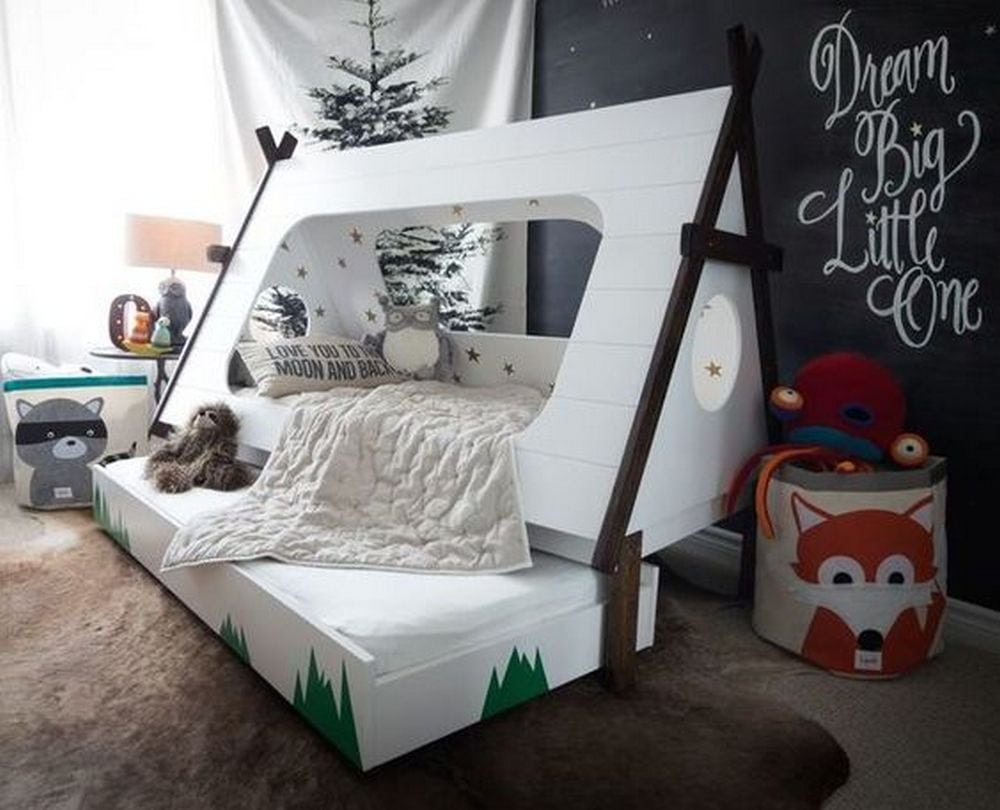
While sleep is a luxury for adults, toddlers do not think of it that way. It most likely is the last item on their to-do list. If you’re having this problem, you are not alone. But fear not, there’s a solution.

A teepee bed is a child’s dream come true. With this, you can easily lure your toddler into sleeping. It’s actually a fun bed that doesn’t feel like a bed at all.
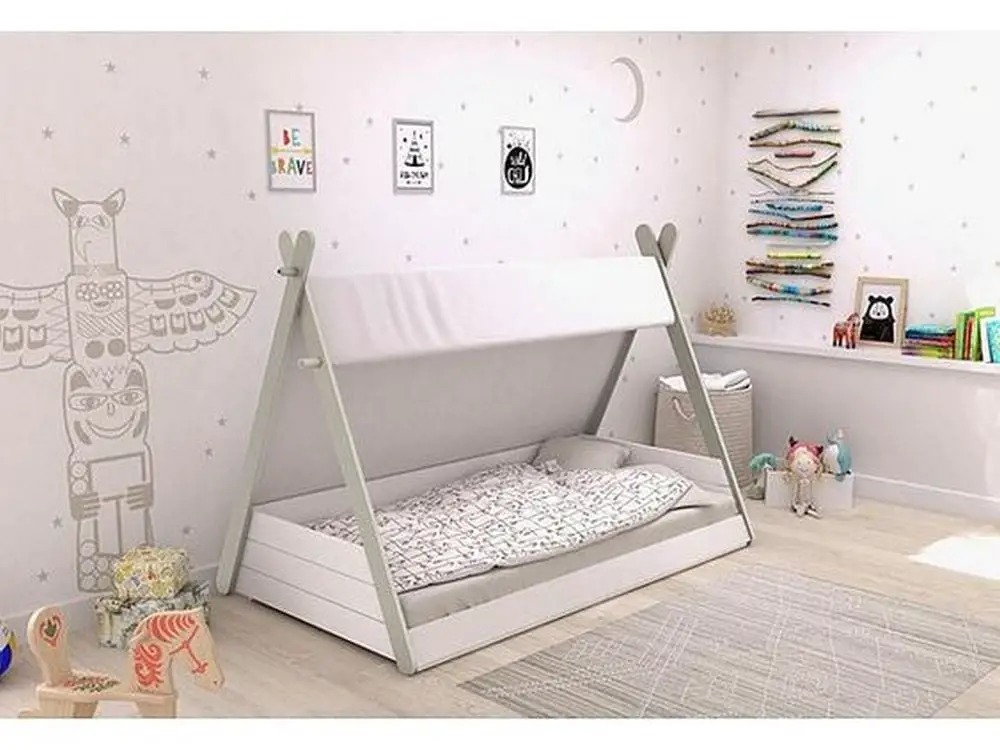
But wait – Getting a bed is expensive. Well, you don’t have to worry anymore; you can easily make one. And it’s not just any bed – it’s a teepee bed!
Contents
Building a Teepee Bed
Materials
- Your choice of wood cut to the desired size
- 4 castors
- screws
- L brackets (vertical and horizontal)
- wood filler
- Enamel paint (color of your choice)
- Primer
- Clear polyacrylic
- Steel wool
- Wood glue
- 2 mattresses
- 2 slatted bed bases
- 80 grit, 220 grit, and 320 grit sandpaper
Tools
- Circular saw
- Jigsaw
- Screwdriver
- Drill
- Vise grips
- Dremel with a surface grinding bit
- Chisel
- Hammer
Instructions
Preparation
- Design Planning: Sketch your teepee bed design, including dimensions and the placement of the entrance. Consider the size of the mattresses and the room where the bed will be located.
- Material Selection: Choose wood that’s sturdy and safe for children. Ensure all materials and paints are non-toxic.
Cutting and Sanding
- Cutting Wood: Using a circular saw, cut the wood to your desired size based on the design. You’ll need four main posts for the teepee structure, plus additional pieces for the bed frame.
- Sanding: Start with 80 grit sandpaper to smooth rough edges and surfaces. Progress to 220 and then 320 grit for a fine finish.
Assembling the Frame
- Bed Frame Construction: Use the drill and screws to assemble the bed frame. Attach slatted bed bases to the frame to support the mattresses.
- Teepee Structure: Arrange the four main posts to form the teepee shape. Secure the top with wood glue and reinforce with screws. Ensure the structure is stable and sturdy.
- Applying L Brackets: Use L brackets at key joints to provide additional stability to the bed frame and teepee structure.
Finishing Touches
- Filling and Smoothing: Apply wood filler to any gaps or screw holes. Once dry, sand for a smooth finish.
- Priming and Painting: Apply a coat of primer to the entire structure. Once dry, paint with enamel paint in your chosen color. Let it dry completely.
- Polyacrylic Finish: Apply a clear polyacrylic coat to protect the paint and wood. This makes the bed more durable and easy to clean.
- Steel Wool Polish: Once the polyacrylic coat is dry, gently polish the surface with steel wool for a smooth, professional finish.
Final Assembly
- Adding Castors: Attach castors to the bottom of the bed frame for easy mobility. Ensure the castors have locks for safety.
- Placing Mattresses: Place the mattresses on the slatted bases. If desired, secure them with strips of wood or brackets to prevent shifting.
Educational and Playful Aspects of Teepee Beds
Teepee beds do more than just offer a cozy spot for children to rest; they serve as a gateway to imaginative play and learning opportunities. By integrating elements of play and education into the design of teepee beds, parents can create an engaging environment that encourages creativity, learning, and development.
Let’s explore how these unique beds can become both a playground and a classroom.
Fostering Creativity and Imagination
A teepee bed is not just a place to sleep; it’s a canvas for the imagination. Children can see their beds as forts, castles, spaceships, or hidden caves, depending on the theme of the teepee. This imaginative play is crucial for cognitive development, allowing children to explore different roles, scenarios, and ideas. Encouraging your child to decorate the teepee with their drawings or crafts can further personalize the space and spark creativity.
Educational Themes
Parents can choose educational themes for the teepee bed that align with their child’s interests or learning goals. For example, a space-themed teepee bed can be adorned with stars, planets, and constellations, offering a nightly lesson in astronomy. Similarly, a teepee bed with a world map can inspire curiosity about geography and cultures. These themes transform the bed into a learning hub, making education a part of the child’s daily routine.
Reading Nook
Incorporating a reading nook within the teepee bed encourages a love for books and reading. By placing shelves or pockets to hold books around the teepee bed, children have easy access to reading materials. This setup not only makes reading more appealing but also creates a comfortable and secluded spot for children to immerse themselves in stories, enhancing their literacy skills and imagination.
Sensory Play Area
Teepee beds can be equipped with elements that stimulate sensory play. Adding textures, lights, and sounds within or around the teepee can engage the senses, which is particularly beneficial for young children’s development. For instance, a soft rug with different textures inside the teepee or fairy lights can create a magical atmosphere that delights the senses and encourages sensory exploration.
Interactive Learning
Integrate interactive learning elements into the teepee bed design, such as educational toys, puzzles, or even a small chalkboard or whiteboard. These tools can make learning fun and interactive, allowing children to practice writing, math, or drawing in a playful setting. It reinforces the idea that learning can be enjoyable and not just limited to traditional classroom settings.
Click on any image to start the lightbox display. Use your Esc key to close the lightbox.
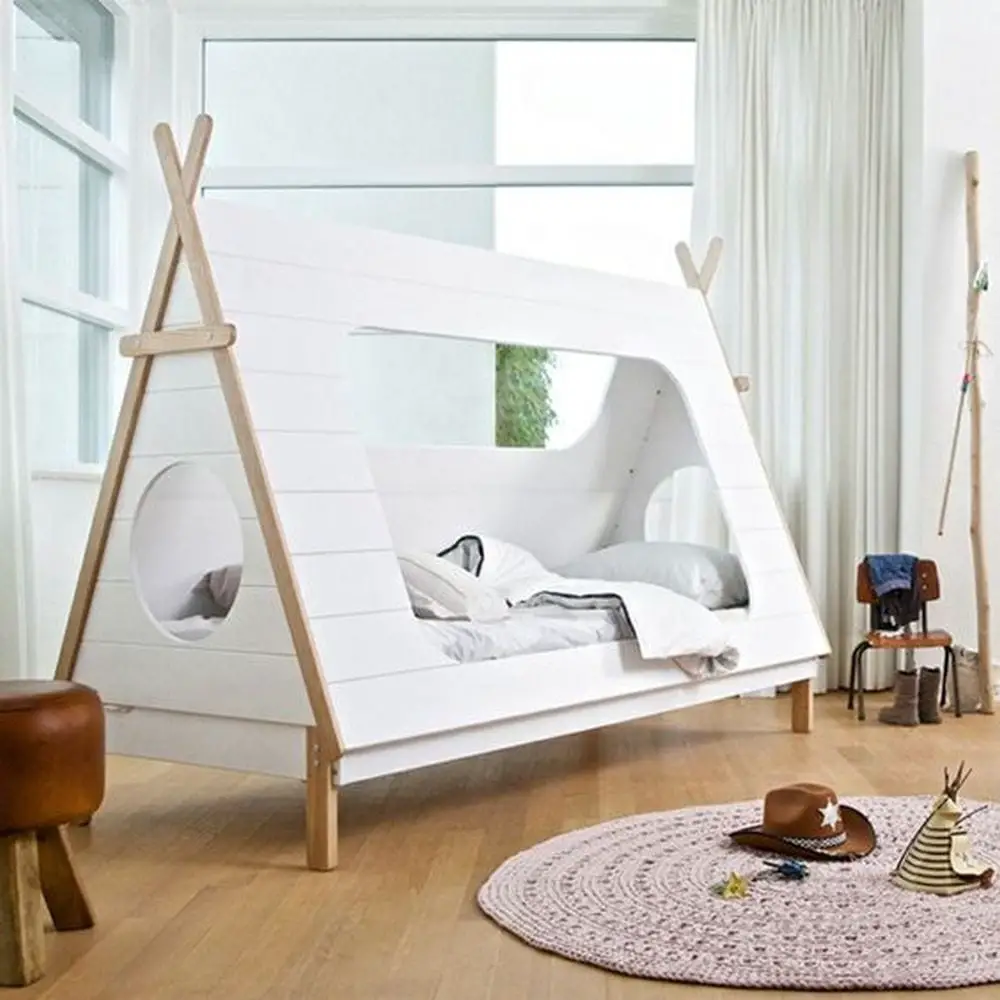
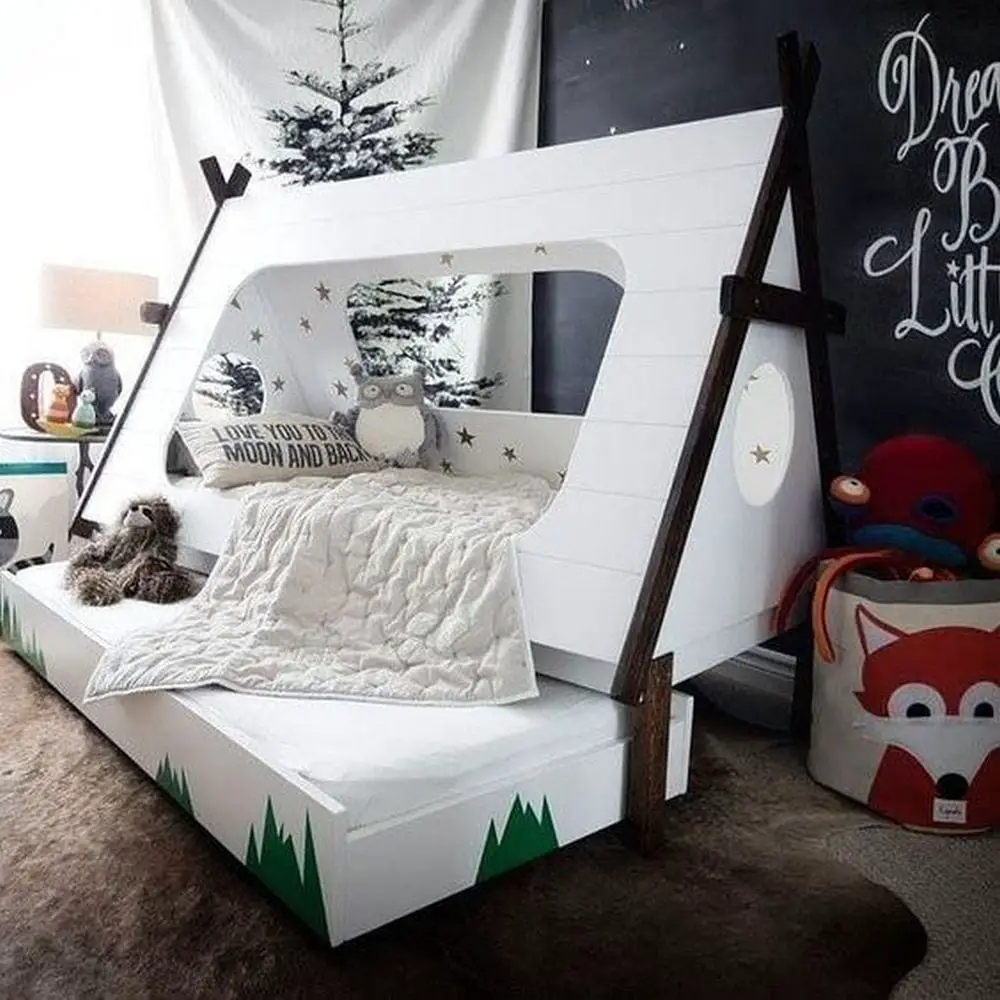
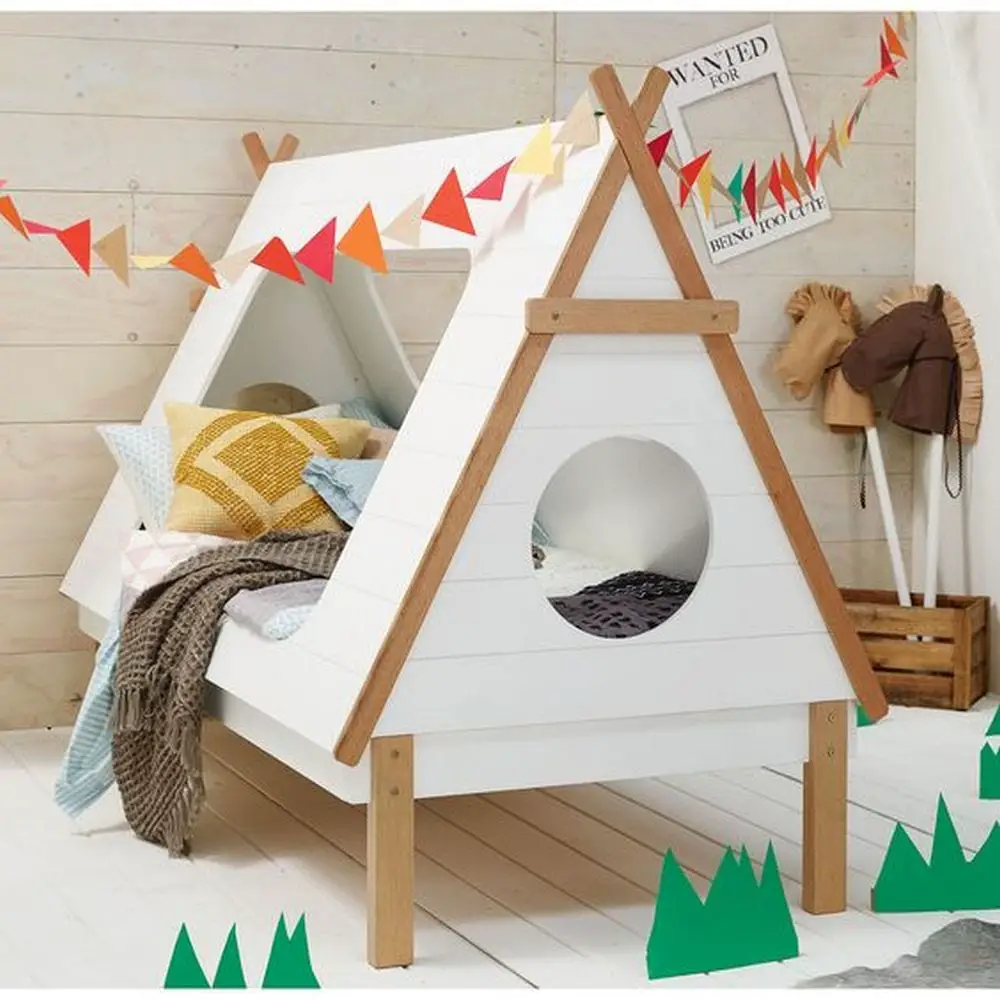






Safety Considerations and Tips
Ensuring the safety of teepee beds is paramount for parents who want to provide a secure and fun sleeping environment for their children. These beds, while offering a unique and playful space, must adhere to safety standards to prevent accidents and ensure a peaceful night’s sleep.
Let’s delve into the key safety considerations and tips for constructing and maintaining a teepee bed.
Sturdy Construction
Ensuring the teepee bed has a sturdy construction is critical to creating a safe environment for children. Selecting high-quality, durable materials for the bed’s frame and support system is essential. Hardwoods or high-grade engineered woods are ideal choices for their strength and longevity.
When assembling the teepee bed, it’s vital to make sure that all parts are securely fastened with robust fasteners, such as screws or bolts, rather than relying on less durable joining methods like glue or staples alone. The design of the teepee bed should include a stable base that distributes weight evenly and prevents the bed from tipping over, even when children are climbing or playing on it.
Regular inspections of the teepee bed are necessary to identify and promptly address any loose screws or weakened joints. This proactive approach ensures the teepee bed maintains its structural integrity over time, providing a secure sleeping and playing area for children.
Non-toxic Materials
The choice of materials and finishes for a teepee bed goes beyond aesthetics and durability; it also impacts the health and safety of the child. It’s paramount to select non-toxic, child-safe paints and finishes for all surfaces of the teepee bed. Look for products labeled as low-VOC or no-VOC, which indicate a minimal presence of volatile organic compounds. These compounds can evaporate into the air at room temperature, potentially causing respiratory irritation or long-term health effects.
Additionally, ensure that the wood, fabric, and any other materials used in the construction of the teepee bed are free from harmful chemicals, such as formaldehyde or lead. This precaution is particularly important for items that children come into close contact with, as young children are more susceptible to the effects of toxic substances.
By choosing non-toxic materials for the teepee bed, parents can minimize their child’s risk of exposure to harmful substances, ensuring a safer and healthier indoor environment. Regularly cleaning the teepee bed with safe, gentle cleaning products can also help maintain a healthy sleeping space for your child.
Smooth Edges and Corners
Ensuring that all edges and corners of the teepee bed are smooth and rounded is crucial for preventing injuries that can occur from bumps and falls. During the construction or assembly phase of the teepee bed, dedicating attention to detail in sanding down any sharp edges or corners is essential. This involves using a fine-grit sandpaper to meticulously smooth out all surfaces that children might come into contact with.
For added safety, consider applying soft corner guards as an extra layer of protection on areas that could potentially come into sharper focus during play. This careful preparation significantly minimizes the risk of cuts, bruises, and other injuries, making the teepee bed a much safer environment for children’s play and rest. Regular checks and maintenance to ensure these surfaces remain smooth over time will help in preserving the safety and comfort of the teepee bed.
Secure Attachments
The addition of decorative elements and attachments can transform a teepee bed into a magical and inviting space for children. However, it is essential to ensure that these features do not compromise the bed’s safety. Fabric canopies, hanging decorations, and other attached elements must be securely fastened to withstand the playful energy of children.
Utilizing sturdy, reliable fastening mechanisms can prevent these elements from becoming loose or detached, which could pose safety risks. Regular inspections for wear and tear are necessary to ensure the ongoing security of these attachments. Small, detachable parts should be avoided to eliminate choking hazards for young children.
Additionally, choosing fire-retardant fabrics and materials for the teepee bed not only enhances safety in case of an accident but also ensures that all decorations contribute to a secure environment. Properly fixed attachments, without creating loops or ties that could lead to entanglement or suffocation, are vital. This attention to detail in securing attachments and decorations ensures that the teepee bed remains a safe haven for rest and imaginative play, free from preventable hazards.
Appropriate Bedding and Mattress
Choosing the right size mattress and bedding is crucial for the safety and comfort of a child using a teepee bed. The mattress must fit snugly within the bed frame to eliminate any gaps that could potentially trap or harm a child. This precise fit ensures that there is no space between the mattress and the frame where a child’s limbs, head, or body could become stuck, reducing the risk of injury or discomfort.
The sheets and other bedding should be specifically chosen to match the mattress size, ensuring they stay securely in place even as the child moves during sleep. This prevents the bedding from becoming loose and creating a hazardous environment.
Additionally, while soft bedding may seem more comfortable, it’s important to avoid excessively plush or thick mattresses and pillows for younger children. These can pose a suffocation risk, particularly for infants and toddlers who might not be able to move away from suffocating hazards easily. Opt for firmer mattresses and minimal bedding, especially for younger children, to maintain a safe sleeping environment in the teepee bed.
Ventilation
Proper ventilation is essential for maintaining a safe and comfortable environment within a teepee bed, especially when the bed is enclosed by fabric. Ensuring adequate airflow is vital to prevent the accumulation of carbon dioxide and to help regulate temperature, keeping the sleeping area comfortable throughout the night. Lack of ventilation can lead to stuffiness, making it difficult for the child to breathe comfortably and potentially disrupting sleep.
To enhance ventilation, consider incorporating design elements such as mesh windows, which allow air to circulate freely while still providing privacy and the cozy enclosure children enjoy. Alternatively, ensuring that the top of the teepee remains open or including venting options at the peak can also improve airflow.
These design choices help to maintain a fresh and oxygen-rich environment inside the teepee bed, contributing to a healthier and more pleasant sleeping experience for the child. Regular checks to ensure these ventilation features remain unobstructed and functional are key to sustaining an ideal sleeping environment in the teepee bed.
Teepee Bed Maintenance and Care
Maintaining and caring for a teepee bed ensures it remains a safe, clean, and inviting space for children. Regular maintenance not only extends the life of the teepee bed but also guarantees that it continues to be a secure haven for rest and play. Here, we outline essential maintenance and care tips to keep the teepee bed in top condition.
Regular Inspection
Conducting regular inspections is crucial to identifying potential issues before they become serious. Check the teepee bed’s structure for any signs of wear and tear, such as loose screws, weakened joints, or frayed fabric.
Ensure all structural components remain sturdy and intact, and tighten any loose fittings immediately. Inspect the bed for any sharp edges or points that may have developed over time and address these by sanding down or replacing affected parts.
Cleaning and Sanitizing
Keeping the teepee bed clean is essential for ensuring a healthy sleeping environment. Vacuum the mattress, bed frame, and any fabric components regularly to remove dust and allergens. Wash bedding and removable fabric coverings according to the manufacturer’s instructions to keep them fresh and hygienic.
For non-removable fabric parts and the bed frame, use a gentle, non-toxic cleaner and a damp cloth to wipe down surfaces. Avoid harsh chemicals that could harm the bed’s materials or pose health risks to children.
Fabric Care
If the teepee bed includes fabric elements, such as a canopy or curtains, proper care is necessary to maintain their appearance and functionality. Check for any rips or tears and repair them promptly to prevent further damage. If the fabric is washable, follow the care instructions closely to avoid shrinkage or fading. For non-washable materials, spot cleaning with a suitable cleaner can help address spills or stains.
Addressing Damage Promptly
Any damage to the teepee bed, whether to its structure, fabric, or accessories, should be addressed promptly to prevent worsening. Replacing or repairing damaged elements not only keeps the bed safe but also ensures that it remains an enjoyable space for the child. Regularly update or refresh accessories and decorative elements to keep the space engaging and reflective of the child’s changing interests.
Seasonal Adjustments
Consider making seasonal adjustments to the teepee bed to ensure year-round comfort. This may include changing the bedding to suit the temperature, adding or removing layers, or adjusting the ventilation for optimal airflow. Such adjustments can help maintain a comfortable sleeping environment regardless of the weather.
By following these maintenance and care guidelines, parents can ensure the teepee bed remains a durable, clean, and cherished part of their child’s bedroom. Regular care not only preserves the bed’s quality and safety but also enhances the overall experience for the child, making the teepee bed a lasting retreat for adventure and dreams.
Conclusion
Building a teepee bed offers a unique blend of fun, functionality, and educational value, transforming a child’s bedroom into a space of endless imagination and learning. It encourages creative play and fosters a sense of independence while ensuring a safe and comfortable environment for rest. With the right materials, careful construction, and regular maintenance, a teepee bed can become a cherished childhood haven. Ultimately, the benefits of constructing a teepee bed extend far beyond just a sleeping space, enriching a child’s developmental journey in a playful and engaging manner.





